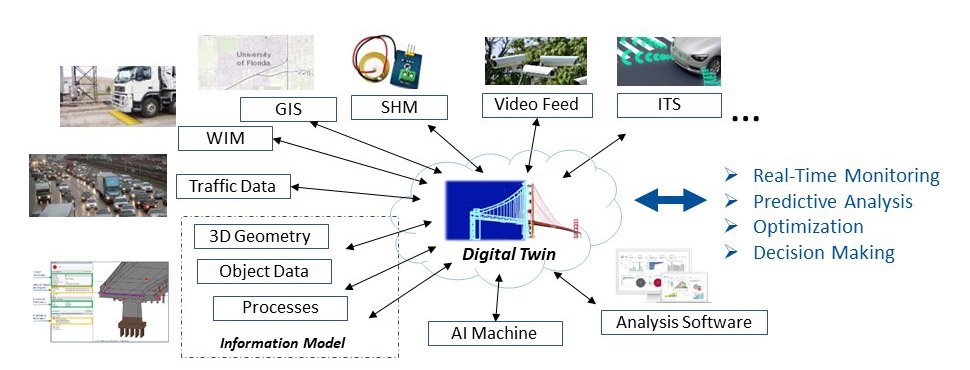Transforming Bridge Maintenance: The power of digital twins for smarter infrastructure management
by dr. aaron costin
A mock-up of a digital twin bridge with sensors attached to microcomputers.
Bridges are vital for keeping our transportation network running smoothly, but they need careful attention to stay safe and functional as they age. By using cutting-edge technologies like sensors, computers, and data analysis, we can create a digital version of a bridge that helps us keep an eye on its condition and make smart decisions about maintenance. This information helps us decide when to fix or check a bridge before it gets worse. It’s like having a virtual assistant that tells us when something might be wrong.
In the context of the current state of U.S. infrastructure, which has its fair share of challenges, the digital twin offers a way to step up our monitoring and management. This involves bringing together currently available technologies such as 3-D modeling software (Building Information Modeling), special sensors that check the bridge’s health (Structural Health Monitoring), smart traffic systems (Intelligent Transportation Systems), and maps that show where the bridge is (Geographic Information Systems).This framework becomes a hub where we gather real-time data, analyze it, and use it to guide how we operate and maintain bridges.
Components of a bridge digital twin.
This idea also helps us learn new things. One of the real advantages of the digital twin concept is its ability to combine data from various sources. When we put all the information together, we can discover new ways to keep bridges strong and lasting. This means we can create a comprehensive understanding of a bridge’s condition and behavior. By blending data from regular inspections with constant sensor data and other relevant sources, we get a full picture of how well a bridge is doing.
Integration of transportation technologies in a digital twin.
A paper titled “Digital Twin Framework for Bridge Structural Health Monitoring Utilizing Existing Technologies: New Paradigm for Enhanced Management, Operation, and Maintenance” will be published soon in the Transportation Research Record (TRR) with co-authors Dr. Jennifer Bridge from the UF Department of Civil and Coastal Engineering and Dr. Alireza Adibfar, graduate of the M.E. Rinker, Sr. School of Construction Management. It will lay out the foundation of how a bridge digital twin works and how it interacts with existing technologies. It digs into practical uses and potential benefits of digital twins for bridges and structures. While there are some technical hurdles to overcome, like making sure different types of data can work together, integrating sensors, and keeping things secure, embracing the bridge digital twin idea holds great promise. It could help us make smarter decisions about maintenance, improve bridge performance, and contribute to the overall betterment of our transportation infrastructure.
This piece was first published via the University of Florida Transportation Institute.
Article Details
Digital Twin Framework for Bridge Structural Health Monitoring Utilizing Existing Technologies: New Paradigm for Enhanced Management, Operation, and Maintenance
Aaron Costin, Alireza Adibfar, Jennifer Bridge
First Published November 27, 2023 Research article
DOI: 10.1177/03611981231208908
Transportation Research Record: Journal of the Transportation Research Board
About the Author




